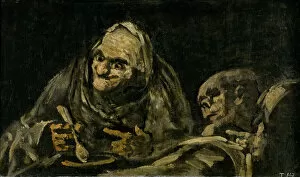Black Paintings Collection
"Exploring the Dark Depths: Francisco Goya's Black Paintings" Francisco Goya, a renowned Spanish artist from the late 18th and early 19th centuries
All Professionally Made to Order for Quick Shipping
"Exploring the Dark Depths: Francisco Goya's Black Paintings" Francisco Goya, a renowned Spanish artist from the late 18th and early 19th centuries, delved into the realm of darkness with his enigmatic collection known as the "Black Paintings. " These haunting works offer a glimpse into Goya's troubled psyche and provide an intriguing insight into his artistic evolution. One such masterpiece is "Pilgrimage to the Fountain of San Isidro, " painted in 1819. This eerie composition portrays a group of pilgrims seeking solace at a sacred site, their faces shrouded in shadows that hint at hidden desires and secrets. In "Judith and Holofernes, " we witness Goya's mastery of depicting violence and horror. The intense scene captures Judith beheading Holofernes, showcasing her strength amidst chaos. The dark tones heighten the tension, leaving viewers captivated by this macabre tale. Goya's fascination with religious themes continues in "Procession of the Holy Office. " Here, he exposes the sinister side of faith through ominous figures marching under dimly lit skies. Their expressions evoke fear and uncertainty, challenging traditional notions of piety. The unsettling nature extends to everyday life as well. In "Two Old Men Eating Soup (The Witchy Brew), " two elderly men engage in an ambiguous act while surrounded by mysterious objects. This painting raises questions about mortality, magic, and human frailty. Goya also explores power dynamics between genders in works like "Man Mocked by Two Women (Women Laughing or The Ministration). " Through exaggerated gestures and mocking laughter, he highlights societal inequalities faced by men within relationships—an unconventional subject for its time. Political satire finds its place among these blackened canvases too. In "The Reading (Politicians), " politicians engrossed in their own agendas are depicted as grotesque creatures consumed by greed—a scathing commentary on the corrupt nature of power.















